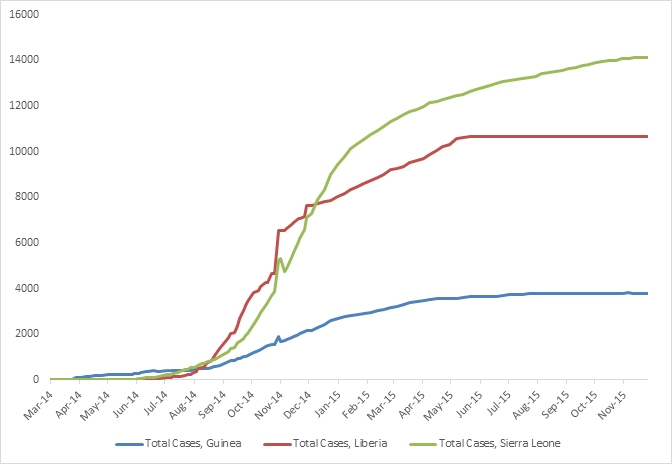An ongoing dialogue on HIV/AIDS, infectious diseases,
November 26th, 2015
Five (OK, Six) ID/HIV Things to be Grateful for this Holiday Season, 2015 Edition
Some quick ID/HIV gratitude items for 2015, done rapidly as we’re hosting a big meal later today.
I wonder what that might be.
- New Ebola virus disease cases and deaths have dramatically declined. I write that sentence with some trepidation, as cases continue to occur sporadically, and this late relapse in a nurse was a chilling reminder of how little we know about this disease. Additionally, since what caused the massive outbreak in Western Africa is still poorly understood, complacency about Ebola would be very ill-advised. Nonetheless, the reason we should be grateful is shown clearly in this figure of Ebola incidence:

Last year at this time we were right in the middle of that steep upward slope, with no idea when or how cases would decline. That these curves have plateaued is due to massive local control efforts (thank you!); work on both a vaccine and antiviral therapy also continue briskly. - Antibiotic prescribing declines. Whether it’s the growing awareness of the importance of the microbiome, concerns about resistance, publicity about the dreaded C diff, fear of drug toxicity, or (most likely) some combination of the above, people are receiving fewer prescriptions for antibiotics. The data from this study confirm something that most clinicians increasingly see in their patients — some sort of tipping point has been reached, where now a growing number of people are willing to tough out community-acquired respiratory infections and nagging coughs and ear aches rather than berate their doctors with references to “green phlegm” (code for “Give me a Z-pak”). Now if we can just get the farm animals to have a voice in this too — 80% of antibiotic use in this country is for agricultural purposes.
- PrEP works really, really well when given to people who want (and need) it. Confession: I thought pre-exposure prophylaxis (PrEP) for HIV was forever going to remain a very small piece of the HIV prevention effort. But I’ve been wrong (many times) before — hey, I thought putting cameras in phones was a ridiculous idea — and it turns out I was wrong about PrEP, too. In both the PROUD and IPERGAY (soon to be published in a major medical journal) studies, men who have sex with men who were at high risk of contracting HIV reduced that risk by nearly 90% by taking TDF/FTC. Not surprisingly, uptake of PrEP has increased dramatically in the past year, a trend I expect will continue given CDC’s efforts to get the word out.
- HCV treatment now works just as well in clinical practice as it does in clinical trials. Remember when combination HIV therapy came out in the mid-1990s, and several papers (notably this one) cited far worse outcomes in “real life” than in the clinical trials? Or when the same exact thing happened with telaprevir and boceprevir-containing regimens for HCV? Guess what — current HCV treatment is so good that “real life” (whatever that means) outcomes are outstanding, with cure rates greatly in excess of 90% for most genotype 1 patients. Although every HCV treater has a few examples of treatment failure, they are just that — a few.
- Treatment as prevention is staggeringly effective in preventing HIV — still. Did anyone expect zero HIV transmissions from HPTN 052 participants with virologic suppression? Or from those individuals in the cohort studies of “condomless sex”? I bet somewhere the Swiss are muttering under their breath (in French? German? Italian?), I told you so. Bottom line is that there really is all but zero risk.
- The end of the “When to Start” debate. The much-anticipated START study showed that even the healthiest HIV-infected people — those with CD4 cell counts > 500 and no symptoms — benefit from immediate antiretroviral therapy, with fewer HIV and non-HIV related serious medical problems. When you add these results to the transmission benefits in item #5 above, the clear answer to the question, “When to start?” HIV treatment is pretty straightforward. Now!
As for the video below, I’ve been waiting eagerly since my 8th grade typing class to see it in action — am very grateful finally to see it.
For the record, the dog doesn’t look so lazy to me, just patient.
Happy Thanksgiving!


A great list Paul. I especially like the part about declining prescriptions for antibiotics. However, I just had a to write a letter to the editor of the Santa Fe New Mexican, our local rag, which published an advertisement masquerading as a front-page news story celebrating the arrival of yet another urgent care center in Santa Fe (this one at CVS). One of the great things about it, according to one of the providers who works there, was that you can go there when you get a cold! I doubt that he’s urging people to come in for colds just so he can educate them about the dangers of antibiotic overuse; business would dry up quickly. I’ll be everybody who goes there with a cold, sore throat, sinusitis, and bronchitis gets an antibiotic, and probably one that is lucrative for CVS. It makes me think of climate change–we celebrate a little progress here and there, but in the end, we’re all toast. To quote John Bartlett, “The microbes will win.”
Thanks, Joel! Regarding the CVS clinics, to be fair they don’t encourage antibiotics for colds. But they certainly do have patients pass through or near the “Cough and Cold” aisle on the way to and from the clinic!
How long a cold lasts without meds: a little more than a week.
How long with meds: 7-10 days.
Paul
The Volk J, Phengrsamy T et al. recently published study of PrEP across two years in Kaiser Permanente San Francisco’s high-risk MSM population showed no new infections at all.